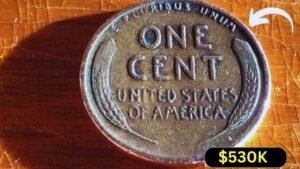Imagine digging through your couch cushions and uncovering a single penny worth more than most people’s annual salary. That’s the reality for one ultra-rare Lincoln Wheat Penny – a 1943-S copper error coin valued at $718,000 that experts say could still be circulating today. This tiny piece of history slipped through wartime minting chaos and now tops every collector’s wish list.
The Origins of the Lincoln Wheat Penny
Launched in 1909 to honor Abraham Lincoln’s centennial, the Wheat Penny replaced the Indian Head design and became America’s first coin featuring a real president. The reverse showcased two wheat stalks, giving the series its nickname. Production ran until 1958, minting billions across Philadelphia, Denver, and San Francisco.
During World War II, copper shortages forced the U.S. Mint to switch to zinc-coated steel for 1943 pennies. But a few blank copper planchets accidentally entered production – creating one of numismatics’ greatest mistakes.
Why the 1943-S Copper Penny Commands $718,000
The $718,000 valuation belongs to a certified 1943-S copper Wheat Penny in pristine condition. Only 10-20 genuine examples are known across all mints, making the San Francisco version exceptionally scarce.
Key Factors Driving Value:
- Extreme rarity – Fewer than 20 confirmed specimens exist
- Historical significance – Represents WWII-era minting errors
- Condition sensitivity – Top-graded coins fetch premium prices
- Provenance – Documented auction sales validate authenticity
| Year/Mint | Composition | Known Examples | Recent Sale |
|---|---|---|---|
| 1943 Philadelphia | Copper | ~12-15 | $282,000 |
| 1943-D Denver | Copper | 1 | $1.7 million (2010) |
| 1943-S San Francisco | Copper | ~6 | $718,000 |
How to Spot a Rare 1943 Copper Penny
Most 1943 pennies are steel and stick to magnets. Genuine copper errors do not. Here’s your quick identification checklist:
Fast Authentication Tests:
- Magnet test – Real copper won’t attract
- Weight check – Copper = 3.11 grams; Steel = 2.7 grams
- Color inspection – Copper shows reddish-brown tones
- Mintmark location – “S” below date indicates San Francisco
Pro Tip: Never clean suspect coins – even light polishing destroys value.
Other Valuable Wheat Penny Varieties
While nothing matches the 1943 copper errors, these dates deserve attention:
- 1909-S VDB – First year with designer initials ($1,000+)
- 1914-D – Low Denver mintage ($5,000+)
- 1955 Double Die – Dramatic doubling on obverse ($10,000+)
- 1944 Steel – Opposite error from 1943 ($50,000+)
Expert Preservation Tips
Protect potential treasures with these collector guidelines:
- Handle by edges only
- Store in acid-free holders
- Avoid PVC plastic flips
- Submit to PCGS or NGC for grading
- Keep detailed records of discovery
FAQs About the Million-Dollar Penny
Q: Can these rare pennies still be found in circulation?
A: Yes, though extraordinarily unlikely. Most discoveries come from old collections or estate sales.
Q: What should I do if I find a 1943 copper penny?
A: Don’t clean it. Get professional authentication immediately through PCGS or NGC.
Q: Are counterfeit 1943 copper pennies common?
A: Yes – many altered steel cents exist. Only certified examples guarantee authenticity.
Q: How much are common Wheat Pennies worth?
A: Circulated examples typically range from 3-25 cents unless they’re key dates.
Q: Has anyone actually found one in pocket change recently?
A: The last verified circulation find was decades ago, but uncirculated examples occasionally surface.
Your Next Move Could Change Everything
The $718,000 Lincoln Wheat Penny proves that fortune sometimes hides in plain sight. While billion-to-one odds face casual searchers, every old jar of coins deserves a second look. Start examining your change today – that dusty 1943 penny might be more than spare change.
Check your pockets, raid your piggy bank, and share this guide with fellow treasure hunters. The next million-dollar discovery could be yours.




